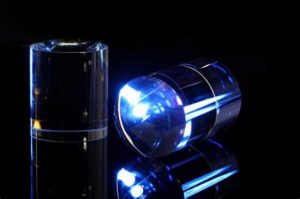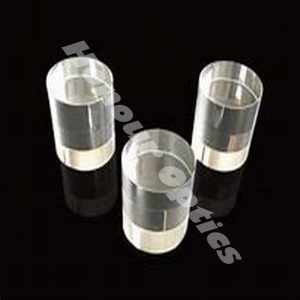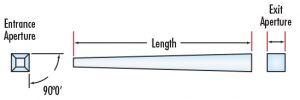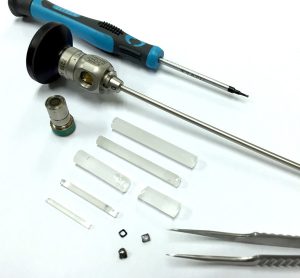

Cylinder lenses can be curved on both sides, though, creating a "rod lens." Rod lenses are unique in that they can be used either side-on or end-on depending upon the application. Here are three examples of their versatility.

Cylinder Lens
When illuminated from the side, rod lenses can be used for the same applications as plano-convex cylinder lenses. Previous examples include line generation, astigmatic collimation, and anamorphic beam shaping. Rod lenses are especially effective as line generators because the double-convex shape has more optical power than a plano-convex shape of the same curvature. Rod lenses, therefore, have very short focal lengths, which results in a larger fan angle.

Light Pipe
A rod lens that is polished on both of its edges can be used to transport light along the length of the rod, from one face to the other. The light stays confined within the rod because of a phenomenon called total internal reflection (TIR), which, in effect, makes the exterior of the rod act as an almost perfect mirror. Rods used in this manner are frequently called "light pipes" and are often used for illumination systems.

Endoscopes
It is also possible to grind and polish the end of a rod lens, creating a long circular lens with a very narrow diameter. Such lenses are ideal for rigid endoscopes, a type of medical instrument used by surgeons to view regions inside the body. Conventional micro-lenses are not ideal for endoscopes because they are challenging to align along the length of the tube. Using rod lenses eliminates this problem because such lenses self-align to the tube diameter. Additionally, rod lenses provide structural support within the endoscope tube. Utilizing rod lenses in this way requires precise matching of the surface curvatures, the lengths of the rods, and the spacing between the rods. It is interesting to note that the inventor of the rod-lens endoscope, the brilliant optical scientist Harold Hopkins (who also invented the zoom lens), solved this difficult optical design challenge using a desktop calculator.
The above examples represent only three creative applications that optical designers have found for rod lenses. Honour Optics carries a wide range of rod lenses, and we also have the capability of fabricating custom cylinder lenses. Give us a call to discuss whether the unique features of rod lenses might improve the functionality of your optical system.
Aspheric lenses can reduce size, weight, and cost of optical systems for medical device, illumination, and other applications. At the same time, their ability to reduce spherical abberation improves optical quality.